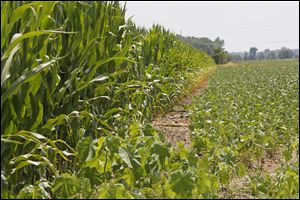
Compensatory loss emphasis of new farm bill
Direct-payment subsidies are shelved for a balanced system
7/22/2014
Corn and soybean farmers in Richfield Township in Lucas County are a small fraction of those who will be affected by the farm bill.
Two years ago, farmers in the four-county Toledo metro area collected more than $10.5 million in direct payments from the federal government, a subsidy program that had become increasingly seen as a poor use of taxpayer money.
Starting this year, those payments disappear. In their place are federal safety-net programs that officials say will slightly reduce federal expenditures and better reflect the purpose of protecting the nation’s farmers in dire times.
“The fundamental political problem that direct payments ran into is a question of fairness,” said Carl Zulauf, an agricultural economist at Ohio State University. “Is it fair farmers were receiving these payments when income was at record or near-record levels? We as a country decided that was not something we felt comfortable with.”
Direct payments were included in the 1996 Farm Bill as a temporary safeguard against bad years, but eventually became permanent. The subsidies drew heavy fire recently as farm income rose to record levels. Mr. Zulauf said as long as farmers met the basic qualifications, direct payments were made regardless of need. In the new system, payments will only be made when certain market conditions exist — either revenue declines or low market prices for grain and other commodities.
President Obama signed the five-year Farm Bill this year.
Agricultural observers say there’s a lot of changes farmers must consider in the new bill, but the implementation of those programs hasn’t yet been sorted out, making an already confusing choice even more complicated.
“What is making that a little harder on farmers right now is that the U.S. Department of Agriculture hasn’t finished at this point setting all the rules and guidelines and essentially setting up the programs,” said Ron Sylvester, a spokesman for the Ohio Farmers Union.
The Ohio Farmers Union has organized a panel of experts to meet with northwest Ohio farmers later this week in Bowling Green in an effort to clear up some of those concerns.
Though the specifics of how the programs will operate are still murky, farmers who wish to participate must choose one of the two general paths.
The first, called price loss coverage, makes payments if the average market price for a crop is less than a previously set reference point. For example, corn’s reference point is currently $3.70 a bushel.
The second, called county agricultural risk coverage, kicks in when actual crop revenue is lower than the country’s benchmark revenue. Unlike price loss coverage, the county agricultural risk coverage applies to total farm revenue, not one specific crop.
Steve Maurer, executive director of Ohio’s USDA Farm Service Agency, said the system is going to be something farmers will have to get used to.
“It’s going to take some study to know which of these options best suit their interests,” he said.
However, he said setting up the system to make insurance from risk a larger portion makes better sense than direct payments.
“When prices were high it just didn’t make any sense to folks, and it was awfully hard to explain,” Mr. Maurer said.
Though that alters farm economics somewhat, the changes have generally been supported by farm organizations.
“This is a fair system,” said Alan Sundermeier, the Ohio State University Extension educator for Wood County. “I know the Corn Growers [Association] and other groups have supported this, knowing the budget needs to be reduced on farm spending and this was a fair way of getting this accomplished.”
Ohio State’s Mr. Zulauf — one of the Farmers Union roundtable presenters — said the overall economic impact of the changes is difficult to calculate, as there are so many variables included in the programs. That’s also part of the reason it’s taking so long to develop the rules.
“As frustrating as it might be, it’s really not unusual,” he said. “It takes a long time to develop rules that are fair and consistent because there are literally hundreds if not more unique situations for individual farmers you have to take into account as you develop the rules.”
The Ohio Farmers Union forum will take place at 1 p.m. Friday in the Grand Ball Room of the Bowen-Thompson Student Union at Bowling Green State University.
Panelists will include officials from the USDA Farm Service Agency, USDA Rural Development, USDA Natural Resources Conservation Service, Ohio State University’s Department of Agricultural, Environmental and Development Economics, and the chief economist of the U.S. Senate Committee on Agriculture, Nutrition, and Forestry.
The event is free and open to the public, but the organizers request that those planning to attend register by contacting Linda Borton online at lborton@ohfarmersunion.org or 800-321-3671.
Contact Tyrel Linkhorn at tlinkhorn@theblade.com or 419-724-6134 or on Twitter @BladeAutoWriter.